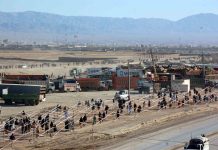Peshawar: Nearly 30 languages in Pakistan are at risk of extinction, according to the United Nations Educational, Scientific and Cultural Organization, of which 15 are spoken in Khyber Pakhtunkhwa.
The UNESCO Atlas of World Languages in Danger lists 27 languages across Pakistan as endangered. The languages at risk in KP fall into three categories: Vulnerable, where most of children speak the language but it may be restricted to a certain domain like home; definitely endangered, where children no longer learn the language as mother tongue in their home; and severely endangered, where a language is spoken by grandparents and older generations, understood by the parent generation but no longer spoken among their children.
The geographical distribution of the endangered languages in KP shows that eight of the 15 endangered languages are spoken in different regions of Chitral, while the rest are spoken in Kohistan, Swat and Dir area of KP. In terms of intensity, two languages – Khowar (222800 Speakers) and Maiya (220000) – are vulnerable. Eight languages – Bateri (29000), Gawar Bati (9500), Phalula (8600), Savi (3000), Torwali (60,000), Ushojo (2000), Yidgha (5500) and Kati (18700) – are definitely endangered, while five languages including Chilisso (2000), Dameli (5500), Gowaro (200), Kalasha (5000), and Kalkoti (4000) are severely endangered.
In absence of census, the population of KP is estimated to be 27 million, with official figures for the populations speaking majority languages hard to come by or at best, guesstimates.
According to a research paper “Language Policy and Localization in Pakistan: Proposal for a Paradigmatic Shift,” the total number of languages spoken in Pakistan are “at least 64, including 58 minor and 6 major languages.” According to 1998 census, Punjabi is the largest spoken language spoken by 44.15 per cent of the population. Pashto ranks second, spoken by 15.42 per cent of the population.
Dr. Tariq Rehman, a linguist, says the basic reason a language disappears is the lack of economic benefit attached to it.
“If there is no job-value in learning a language, the native speakers will ultimately shift to the dominant languages that promise economic benefits,” says Rehman. “Thereby, they put an end to an entire culture, society, history, folklore, becoming clones to other cultures. This phenomenon is referred to as language murder, suicide or more specifically, language shifting.”
To promote and protect local languages from disappearing, Senator Karim Ahmad Khwaja of Pakistan People’s Party Parliamentarian (PPP-P), moved a constitutional amendment bill on July 27, 2016, in the Senate of Pakistan. However, the Senate Standing Committee on Law and Justice deferred the bill on September 1, 2016. The Committee said the provinces were more relevant fora to take up such a bill pointing to a Constitutional clause empowering provincial assemblies to deal with language issues.
But, to Rehman, mere lawmaking is not enough to preserve a language. What matters is implementation of the laws. Although efforts are made by the non-government sector to introduce local languages in school curriculum, says Rehman, that capacity is limited. With government support, endangered languages could be preserved through “Reverse Language Shift”, he says.
“The first step should be to introduce these languages in school curricula,” says Rehman. “This will result in creation of jobs in the form of teaching staff, story writers, programme production for radio and television, literature, songs, and artists. This will pave the path for revitalization of the endangered languages.”
Dr. Khadim Hussain, linguist and Director of the Bacha Khan Trust Educational Foundation, told Truth Tracker, “The term ‘regional’ in itself is derogatory; it is an insult to a language to be treated as regional language. All languages spoken in Pakistan are national in that they belong to us and it is our collective responsibility as a nation to work towards protection and promotion of all these languages.”
Hussain says promotion and protection of national languages is primarily the state’s responsibility, adding that while provincial assemblies are better suited to taking up the matter of moribund languages, the national government also has a role to play.
“States that do not tolerate diversity will ultimately promote an exclusive mindset and discourage plurality such as diversity of languages,” said Hussain. “To revitalize endangered languages, it is necessary to compose written script of that language, introduce it in primary schools and compile popular music and poetry. If these steps are carried out simultaneously, languages could be preserved.”
Hussain says language is not just the identity of a person but a vehicle for indigenous wisdom through centuries that will disappear with the death of language.
He said languages like Pashto, Hindko, Seraiki, Torwali and Khowar should be introduced in primary schools as media of instruction and as compulsory subjects in secondary schools. “Gradually it should be linked with the market. Printed or recorded material in different languages should be sold in the market and these languages should be introduced in the domain of games, media, business, education – even in the provincial assembly.”
In 2012, the ANP government passed a Khyber Pakhtunkhwa Promotion of Regional Language Authority Act. However, the authority has not been established yet. “If the authority is created,” says Hussain, “all endangered languages can be revitalized through documentation, preservation of popular music, poetry and indigenous wisdom over the next 10 to 15 years.”
He criticized the PTI led government for discouraging diversity by making English and Urdu the primary language of instruction in schools.
According to Dr. Salah Uddin, Vice Chairman Gandhara Hindko Board, it is the responsibility of both central and provincial governments to make efforts for promotion of regional languages. Among the languages spoken in KP, he says, only Pashto and Hindko are patronized by authorities. Other small languages in need of preservation are ignored.
”We need to take the first step by introducing languages like Pashto, Hindko, and Khowar in primary schools,” he says.
“We can gradually include smaller languages in this endeavour. They have the same rights as other languages; it does not matter whether they are in minority or majority. Every language needs to be preserved and promoted.”



